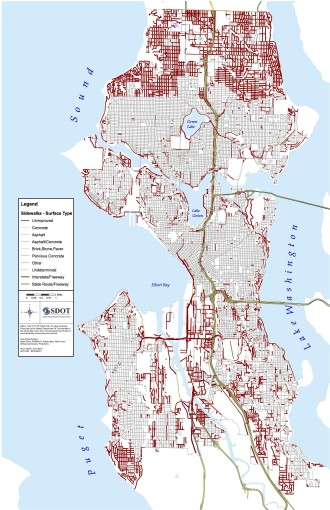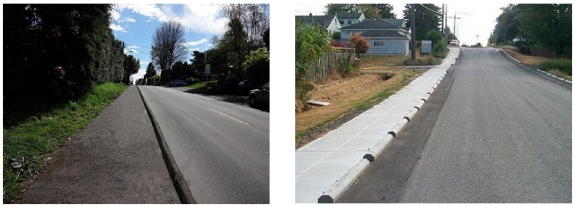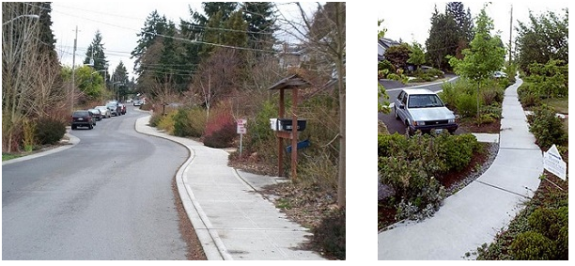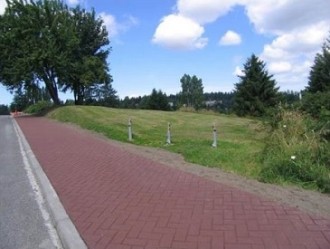
Building neighborhoods without sidewalks was a truly terrible idea.
I mean, seriously. What the hell? If you’re building a place for people to live, how can you leave out the space for people to walk? It’s absolute insanity, and it happened in suburbs all over the nation (and no, it wasn’t an accident).
And the Seattle area is no exception. There aren’t too many places within the old Seattle borders without sidewalks, but many neighborhoods north and south that have since been annexed were built by people who never intended for people to walk beyond their front yards. I mean, flying space cars were just on the horizon, so why waste money on something as mundane as walking?
Well, it turns out people like walking. But retrofitting sidewalks onto existing streets is way more expensive than just doing it right the first time. In fact, it costs about $300,000 just to build one side of one block. The estimate to build all the city’s missing sidewalks? A whopping $3.6 billion. That’s three Move Seattle levies.
So if we realistically want to solve the walkability challenges in the north and south neighborhoods, we need to find cheaper ways to build more safe and comfortable walking routes more quickly. There are a variety of different ways to improve walking safety and comfort beyond the standard sidewalk, and the city wants to hear your thoughts on some of their ideas as part of the ongoing updated to the Pedestrian Master Plan.
Take this survey and let them know.
Some streets may need little more than a raised curb or line of parking stops to create a new dedicated walking space, as shown in these photos from the survey:
 Other streets could get a sidewalk on just one side of the street that is integrated with gardens to catch and filter rainwater. A growing body of research shows that some of our most damaging stormwater toxins can be made much safer for salmon and other sea creatures just by filtering it through dirt. And the more rainwater we can keep from flowing into sewers, the more we can prevent harmful overflows that allow raw sewage to escape into our waterways.
Other streets could get a sidewalk on just one side of the street that is integrated with gardens to catch and filter rainwater. A growing body of research shows that some of our most damaging stormwater toxins can be made much safer for salmon and other sea creatures just by filtering it through dirt. And the more rainwater we can keep from flowing into sewers, the more we can prevent harmful overflows that allow raw sewage to escape into our waterways.
And from a funding perspective, solving these problems is worth a lot of money to Seattle Public Utilities, making them a potentially great partner in creating safer streets that also retain and filter more rain water.

 And to cut costs even further, the city is also implementing cheaper asphalt sidewalks that are dyed and stamped to look like brick. This lower cost will help the city build 250 blocks of sidewalk instead of the 150 originally planned if voters approve the Move Seattle levy.
And to cut costs even further, the city is also implementing cheaper asphalt sidewalks that are dyed and stamped to look like brick. This lower cost will help the city build 250 blocks of sidewalk instead of the 150 originally planned if voters approve the Move Seattle levy.
That’s one more reason we need to pass Seattle’s Prop 1.
The levy will also fund new safe crossings at busy streets and build 60 miles of neighborhood greenways, which can be designed to make walking on sidewalk-free streets much more comfortable and safe by lowering car volumes and speeds.
If some neighborhoods also implement local improvement districts to fund sidewalks, that could also help stretch the city’s sidewalk dollars even further.
As frustrating as it is that these neighborhoods were built without sidewalks, that’s just the way it is. It’s time to stop complaining and start funding creative solutions.








Comments
31 responses to “What do you think of Seattle’s low-cost sidewalk plans?”
The goal is good – some of the photos gave me some pause. Years ago, King County tried a number of these techniques to establish separated, buffered walking routes in what was then unincorporated King County. This included the use of extruded asphalt and concrete curbs as dividers – VERY similar to some of the photos. On more than one occasion these curbs were broken (ostensibly by errant motor vehicles), and the debris then caused major injury to bicyclists who hit the debris as well as creating tripping hazards for pedestrians. A couple of these resulted in MAJOR settlements being paid by the County.
Not an argument against doing this, but a reminder as pointed out in the article that the cost of doing things right the first time is often a bargain.
Easing the codes to allow for cheaper sidewalk construction is a big win. In general, it would be great to have more sidewalks.
However, let’s figure out the problem we’re really trying to solve. What exactly constittues a walkable place? It’s much more complicated than sidewalks = walkable, no sidewalks = not walkable. Some of the most walkable places in the world have no sidewalks. Furthermore, you can just look at Aurora & 155th if you need an example of a place with magnificent sidewalk infrastructure where nobody walks.
If it costs $3.6B to make sidewalks the old way, then even if they cut the cost in half that’s still $1.8B. Sidewalks are needed if and only if we do not sufficiently tame cars. Maybe the $1.8B would be better spent on traffic calming measures rather than sidewalks.
A lot of the areas to the North are built like suburbia — curvilinear streets, housing developments being totally separated from shopping centers, etc. Suburbia isn’t unwalkable because of the lack of sidewalks — it’s unwalkable because those areas occupy land in a way that makes walking impossible. If there’s nothing in walking distance from your front door, it doesn’t make a big difference whether you have a sidewalk or not. Let’s try to prioritize things a little better before we set out to spend billions of dollars we don’t have.
Just take a look at the WalkScore at Blue Ridge:
https://www.walkscore.com/score/nw-blue-ridge-dr-seattle-wa-98177
Score: 19/100. “Almost all errands require a car.”
If you build some sidewalks here, whether it costs $300,000 per block or $200,000 per block, people who live here are still going to drive for 90% of their trips since there are simply no destinations nearby. Trust me, I wish this wasn’t the case!, but there it is.
Isn’t Aurora and 155th part of the Interurban Trail? It’s pretty bright on the Strava heatmap. http://labs.strava.com/heatmap/#15/-122.35030/47.73782/blue/bike It could use much better East-West connections, though.
To me the vast majority of North Seattle is very grid-like. It’s kind of like Maple Leaf or Wedgewood minus the sidewalks. Some of the curvier bits like Alicia Park actually do have sidewalks. You can eyeball that by zooming in on the map.
Yeah, places like Blue Ridge seem to be the exception when looking at places without sidewalks; even Arbor Heights is pretty gridded. I was going to ask how much it would cost to sidewalk just the gridded areas, but you don’t save much and you miss some places that could benefit from sidewalks (like Commodore Way). What about just sidewalking Greenwood, historically the squeakiest wheel on this issue? But then you miss Lake City and Northgate…
@Tim Since when does a bicycle trail that gets used a lot for recreation have anything to do with walkable neighborhoods. There is a distinction between physically being able to walk through a place vs a walkable neighborhood. Walkable neighborhood = a place where residents can get to most of their daily needs on foot, comfortably & safely.
@Morgan Yes, many neighborhoods in N. Seattle have gridded streets. But most of those places have very low Walk Scores — stuff is just too far apart. People in Bitter Lake, Lake City, or Olympic Hills aren’t going to walk to the grocery store even if there are sidewalks. Maybe there are smarter ways to make these places walkable than spending $3B of non-existent money on sidewalks.
Man that Strava heatmap once again points out way Eastlake needs protected bike lanes ASAP.
What’s also telling is how devoid the rainier valley and skyway are. Do people not bike there because they don’t want to bike at all or because it’s too dangerous?
Caveat: I wonder how reliable Strava is. Which riders tracks their rides? Commuters? Weekend riders? It’s hard to know if it is showing a good representation.
Strava tracks wealthier, early-adopter cycling and tech enthusiasts. That does include many commuters around here, but it also definitely excludes many people whose riding is more pragmatic than enthusiastic.
The location at Aurora & N. 155th is not in Seattle, it is in Shoreline and not covered by the Move Seattle Bond.
I filled out the survey but the main emphasis was, I think, on acceptability of different kinds of surfaces. They all look fine in the photos, but how am I supposed to know what they are like in practice? I’ve seen plenty of asphalt walking areas that are lumpy and full of cracks. While they may be fine when new, I am very skeptical that they are worth putting money into, only to save 30% of cost up front.
This is an excellent point, especially given our inability to fund maintenance for our infrastructure. Two summers of tree root growth and most of those asphalt walking paths will no longer be accessible.
Asphalt can make a strong, durable sidewalk. What matters isn’t the top course, but how the ground is prepared underneath. Will these cheap walkways have proper excavation, structural fill, compaction, etc. to support asphalt?
The tried and true standard plan is economical and long lived.
The life cycle costing of asphalt should eliminate it as a possibility. It’s cheap and non-structural and can’t have any trees – even small ones – (or grass for that matter) planted anywhere near it. Very high on the maintenance end and short lived.
Planting strips separate pedestrians from cars and provide a place for rain gardens to happen.
Having no sidewalk does not always mean no place for pedestrians. There are streets where it’s safe to walk in the street and having no sidewalk means that the street belongs to the pedestrian, too.
I grew up on a street with no sidewalk. And thinking about this topic made me ask myself: Would I want a sidewalk added to the street I grew up on? The answer was very strongly no. Where would the sidewalk go? I doubt they would have narrowed the street. And I remember fondly walking down the street four or five of us in a row. I doubt they’d put in sidewalks wide enough for that. And sidewalks are almost never as smooth as the street.
There are a lot of places where it’s really important that we add or improve sidewalks. But, don’t cookie cutter this.
I really appreciated that the survey includes thinking around alternatives to sidewalks as one of the options. And I’m glad for bicycling we consider options like greenways and calm streets. I’m mostly reacting to your leaving no space for people comment at the beginning of your post. I mean a lot of the bike movement is saying street space belongs to everyone and I wouldn’t want anyone to think that no protected bike lane means no space for me.
Hmm.. Kinda want to edit the last paragraph now. I think what we want is everyone to be able to get everywhere not that every bit of street space has to belongs to everyone. I mean I’m totally fine with pedestrian only streets and I’d be quite happy if I never bicycled on a freeway shoulder ever again (assuming there was a good alternative). But, you get my point, I hope.
I generally agree. There’s some sort of balance defining these things and it’s hard to say exactly what it is. Traffic levels have something to do with it. Residential streets can get very different levels of through traffic depending on where they are in the street network. N 90th St between Aurora and 3rd Ave NW is designed like every other side street but gets so much cut-through traffic it might as well be an arterial. But then the number of people walking matters, too, as in Pike Place. Sadly it’s rare for streets to have enough people walking (or biking) on them to really set the tone for the space.
I’ve heard that there are studies showing that people living on residential streets with sidewalks walk more and are safer doing so, but I’m not sure they’re controlling for everything.
A note on cut-through residential streets. One of the best ways to mitigate cut through traffic is to make it too inconvenient. The easiest is to ensure that there is only enough room for one lane of traffic – like many residential streets in Seattle.
If sidewalks are installed on such streets, they could be located such that, with parked cars, the remaining space is about 10′ wide.
Personally, I think this is much more effective than speed bumps, blocked access at one end, or chicanes.
Why does my neighborhood have low curved curbs instead of squared off ones? Horrible. Allows people to park cars and trucks too easily up on sidewalk.
Yes, it was mighty stupid to build residential neighborhoods with no sidewalks. An equally stupid idea is upzoning those no-sidewalk neighborhoods to allow townhouses, triplexes, and stacked flats. Let’s be putting higher densities in walkable neighborhoods with good transit access.
Let’s make more “walkable neighborhoods with good transit access.” By upzoning neighborhoods that don’t now meet that bar and allowing light commercial use.
But it’s not just upzoning that is needed to make more walkable neighborhoods with good transit access. We have to spend the money on the necessary sidewalks and transit improvements. The only way to get there is through a thoughtful planning process, one that identifies the locations where such new urban villages should be located, not blanket citywide up zones.
RDPence is right that we need commensurate transit improvements to match upzoning, but we don’t need to spend a cent on sidewalks. Building sidewalks has always been the purview of developers. If property owners want a sidewalk on their street, the city should make it easier for them to build it, but building it for them isn’t the city’s job.
As much of a pain as redevelopment can be, I’ll admit it’s the best way to get sidewalks built.
Kind of straining to grind that ax there. :-)
I agree with Katie: some neighborhoods are better without sidewalks. I’m in Surrey Downs adjacent to Bellevue downtown. My walkscore is 81, across the street it’s 89.
My neighborhood has no sidewalks and I don’t want them, for two reasons. One, most houses have gardens that go up to the street–putting in sidewalks will devastate the beautiful landscaping.
The second, more important reason is that drivers expect to see people walking in the streets right now. There’s easily enough room for a couple of cars and a couple of people. If you move people onto sidewalks, drivers will go faster. But the kids will still occasionally play ball and skateboard in the streets. And adults will still cross the street to get to their mailboxes. When drivers are used to barreling down our wide suburban streets at 40+ MPH not expecting to see anyone in “their streets” it will be very dangerous to set foot in the streets at all.
So yes, sidewalks are good. But NIMBY :)
By this logic you should also have dirt roads that are full of pot holes
William, I’m saying that cars and people can share low speed, low traffic residential streets. But expectations have to be aligned.
Your dirt and potholes would make it safer for pedestrians. Thanks for the insightful commentary.
Simple plan. Make every developer who wants to develop a block, fund proper sidewalks on two.
If it’s a major development (over 40 units or so), sidewalks should be provided to the nearest transit street. (I saw a condo in Lake City, only 4 blocks away from Lake City Way, and sidewalks on only one of those 4 blocks. Dumb, dumb, dumb)
[…] of Seattle has sidewalks, says Tom Fucoloro at Seattle Bike Blog, but some of the more recently annexed sections of the city do not. The cost to fill in the gaps […]
[…] Stamped sidewalks: http://www.seattlebikeblog.com/2015/10/30/what-do-you-think-of-seattles-low-cost-sidewalk-plans/ […]